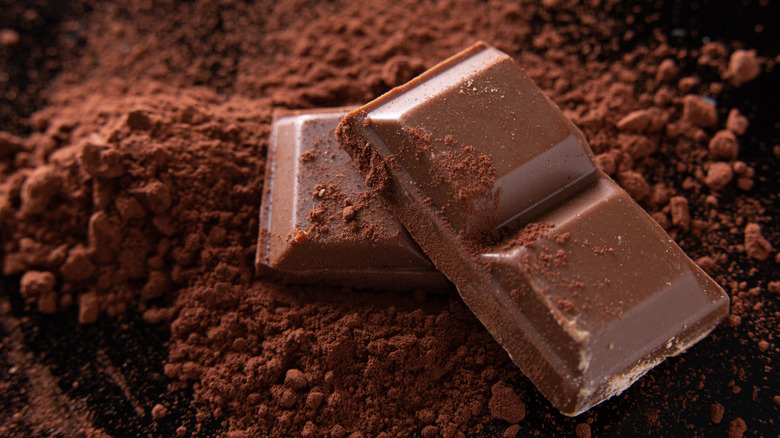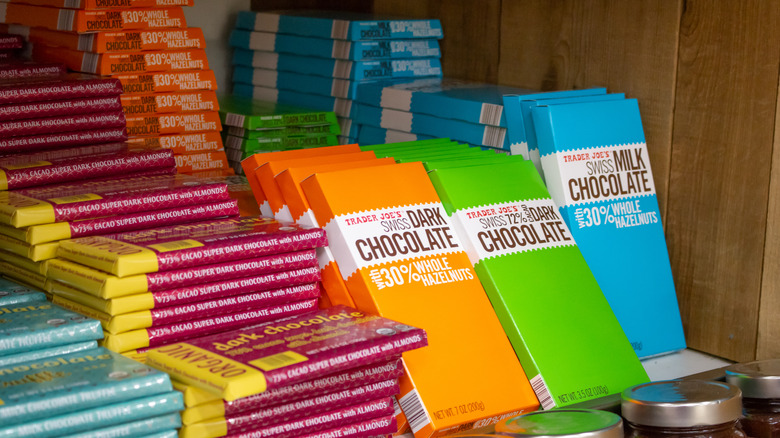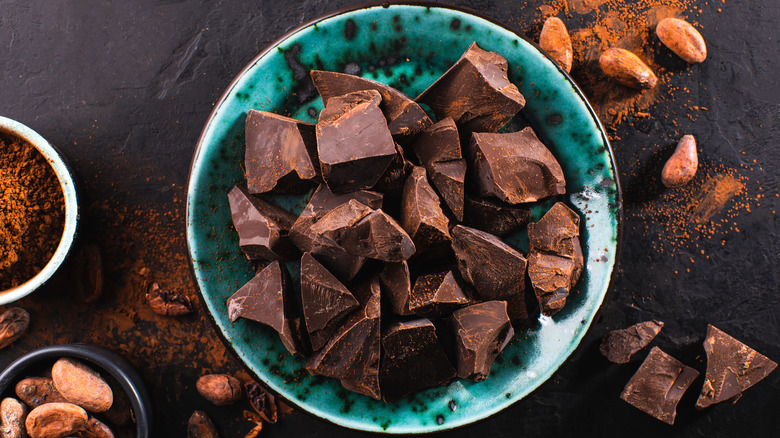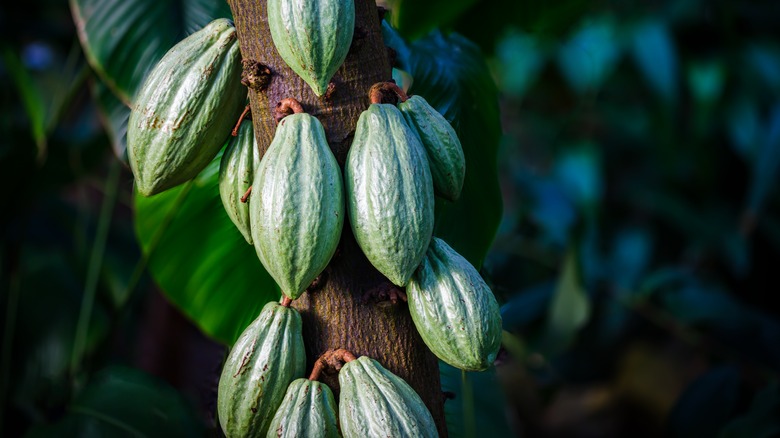Consumer Reports Found Lead In Dark Chocolate From Trader Joe's, Lindt, And More
It might be impossible to think of the word "craving" without conjuring an image of chocolate. According to the American Heart Association, Americans spend $22 billion on chocolate every year. In 2015, CNBC reported that Asia Pacific chocolate fans shell out an estimated $14.3 billion on the stuff annually. Chocolate fanatics in Germany and Austria consume 8 kg (roughly 17 pounds) of chocolate per person, per year; in Switzerland, it's 20 pounds. The fanbase is global, and it isn't going anywhere. Johns Hopkins Medicine says dark chocolate can promote heart health, boost the immune system, stimulate neurological function, lower stress, and even lower the risk for diabetes.
But, James Rogers, director of food safety research and testing at Consumer Reports, says folks need to take a second look at their dark chocolate consumption and the "Health halo" surrounding the sweet (via Today). A new study by Consumer Reports is out, and the findings might kill your craving.
Consumer Reports tested a sample of 28 chocolate bars for heavy metals and found lead and cadmium in all of them. Twenty-three of the 28 bars packed enough lead or cadmium content in just an ounce of chocolate to exceed the value of what is considered safe for human consumption. Five of the 28 bars exceeded harmful levels for both metals. The chocolate brands with these harmful metal levels include Hershey's, Trader Joe's, Dove, Ghirardelli, Lindt, and many others.
High levels across the board
The Consumer Reports study used California's Maximum Allowable Dose Level, which is 0.5 micrograms (mcg) for lead and 4.1 mcg for cadmium, as a gauge. The results? Lindt, Dove, Alter Eco, Beyond Good, Equal Exchange, Pascha, and Scharffen Berger chocolate brands tested highest for cadmium. Tony's Chocolonely, Godiva, Lindt, Trader Joe's, Hershey's, Hu, Chocolove, Lily's, and Endangered Species all tested high in lead. Certain Trader Joe's chocolate bars tested high for both lead and cadmium. Mast, Ghirardelli, Taza, and Valrhona exhibited the lowest levels of the metals.
In adults, lead and cadmium exposure can suppress the immune system, cause hypertension, and damage the nervous system. It's not the kind of thing you want to discover in your chocolate bar. Per the CDC, high levels of lead exposure have been linked to brain and kidney damage, anemia, and cancer. It can also stunt physical and neurological development in young children, who, incidentally, tend to be among chocolate's most enthusiastic and steadfast fanbase. Chocolate bars are positioned at child eye level in supermarket checkout lines for a reason.
The National Confectioners Association says dark chocolate is safe to consume
The National Confectioners Association provided Tasting Table with a statement on the Consumer Reports study, writing "The California Office of Environmental Health Hazard Assessment (OEHHA) standards cited ... are not food safety standards," and that the association previously investigated the cadmium and lead levels in chocolate and found them to be safe to consume. The industry group says the heavy metals come from the soil where cocoa plants are grown, and these levels are reduced during the bean processing step of chocolate making.
The National Confectioners Association stated, "the products cited in this study are in compliance with strict quality and safety requirements," and explained the levels of heavy metals found are in accordance with the guidelines established during a 2018 settlement with group As You Sow over California's Proposition 65 labeling law (via As You Sow). The National Confectioners Association also reaffirmed its commitment to both food safety and quality.
Solutions may take a while to kick in
Heavy metals can slip by undetected in cocoa solids, and, according to toxicologist Michael J. DiBartolomeis, Ph.D., dark chocolates are generally at least 65% cacao per weight, via Consumer Reports. According to the consumer safety organization As You Sow, the exterior shell of cocoa beans is coated with "baba," a sticky pulp that makes lead-contaminated soil and dust stick to the beans during processing. The lead in turn gets absorbed into the beans and transferred to the chocolate bars. Cadmium, however, is entering the cocoa beans before they're even harvested. Cocoa bean plants take up cadmium in the soil through their roots while they're still growing. Dr. DiBartolomeis suggests replacing older cacao trees with newer ones as cadmium levels increase in the plants as they age or relocating cocoa farms to areas with lower soil cadmium levels, but the transition will require time as entire farms regrow. The other solution is to genetically breed cocoa plants to absorb less cadmium through their roots, but that would require even more time to take effect.
With these altered practices in place, says The National Confectioners Association, consumers could reasonably expect to see lead levels reduced within one year, but cadmium is going to take a little longer to drop.



